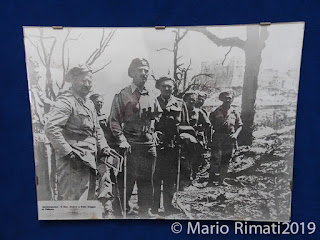Monte Cassino is located about 90 kms south of Rome. Its history is linked to the nearby town of Cassino which was first settled in the fifth century B.C. by the Volsci people who held much of central and southern Italy. It was the Volsci who first built a citadel on the summit of Monte Cassino.
Fast-forward a few centuries and to the 1940s. We get to the point when
the Benedictine monastery was literally razed to the ground by Allied bombers during the battle
of Monte Cassino and during the Italian Campaign of World War II. From January–May 1944 the Abbey was heavily damaged by approximately 400 tons of
bombs, mostly from the American-led air raids. The German military forces had
established the 161-kilometre “Gustav Line” in order to prevent Allied troops from
advancing northwards. However, the Abbey
itself was not initially utilised by the German troops as part of their
fortifications owing to General Kesselring’s admiration for the
historic monument.
It had actually been the Commander-in-Chief of Allied
Armies in Italy, General Sir Harold Alexander of the British army, who had
ordered the bombing. The bombing was carried out because many reports from the
British commanders of the Indian troops on the ground believed that German
soldiers were occupying the monastery.
It had been considered a key observational post by all those who were fighting there. However, during the bombing no Germans
were present in the Abbey. Subsequent investigations found that the only people
killed in the monastery by the bombing were 230 Italian civilians seeking
refuge there. After the bombings the
German paratroopers of the 1st
Parachute Division occupied the ruins because they provided excellent defensive
cover.
More precisely, on February
15th, 1944 from 9:45 am to 12:20 pm 147 Allied “Flying Fortresses” dropped
297 tons of bombs on the Abbey (each bomb weighed 250 kg) and with 66 tons
of incendiary bombs (weight: 50kg each).
This was followed by 47 B25 bombers and 40 B26 bombers which dropped 100
tons of bombs.
Many
believed that the truly massive bombing was useless. Even America’s General Clark, the Commander
of the 5th Regiment, said that the bombing had been an error seeing
that the Monastery didn’t hide German soldiers nor machine-gun nests. The few German soldiers who did go there, and
only because the old abbott allowed them to do so, went instead for
confessional purposes.
One month
later a whopping 775 Allied planes dropped 2,500 bombs on the nearby town of
Cassino killing many innocent Italians.
On May 18th, 1944 General Enders and his brave Polish troops
conquered the ruins of Monte Cassino. And
there, just 1 km away from the mountain at the Polish War Cemetery lies
General Enders (along with his wife) and his 1,000 loyal Polish soldiers who died
during their battle against Hitler’s troops.
In December 1943, some 1,400 irreplaceable
manuscript codices, mainly patristic and historical, in addition to a vast
number of documents relating to the history of the Abbey, were sent to the Abbey's archives for
safekeeping. German officers Lt. Col. Julius Schlegel and Capt. Maximilian
Becker from the Hermann Goring’s Panzer-Division had them transferred to
the Vatican at the beginning of the battle.
The Abbey was eventually rebuilt from scratch after
the war and Pope Paul VI consecrated the rebuilt Basilica on October 24,
1964 (St. Benedict was made the patron saint of Europe). The VERY rich museum also contains a magnificent painting
by the Renaissance master Sandro Botticelli.
A good time to visit the Abbey and the museum is on
Sunday.





















































































































































